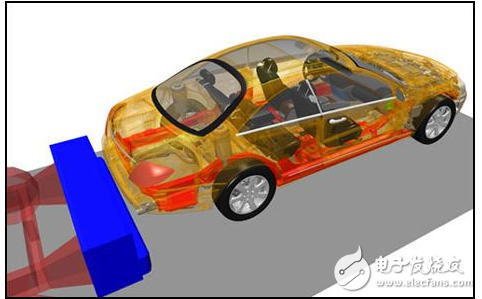Millimeter wave anti-collision radar becomes a solution for car collision avoidance
In the process of developing advanced assisted driving and automatic driving, the automatic/assisted driving function will gradually replace the human initiative. The most important technology is the collision avoidance system that senses the surrounding environment of the car. The millimeter wave radar has the characteristics of high measurement accuracy, simple structure and low price, and is suitable for short-distance accurate measurement, and is being applied to a vehicle collision avoidance system on a large scale. At present, the technical solutions of automobile collision avoidance systems include millimeter wave radar, laser radar, infrared radar, camera and the like. The millimeter wave radar is less affected by the natural environment and has a moderate detection distance. It is the most cost-effective in the field of vehicle radar, but it is difficult to identify pedestrians, traffic signs, etc. The laser radar has high measurement accuracy and can be used to establish spatial three-dimensional maps in real time, but the cost is high. Rain, snow and fog have poor effects; infrared radar has high measurement accuracy, mature technology and low cost, but the measurement distance is close (less than 10m), which greatly limits its application scenarios; the camera has low cost and can identify objects. It is an indispensable sensor for lane departure warning and traffic sign recognition, but it has the disadvantages of relying on light, failure at night and extreme weather, and difficulty in accurate distance measurement. Various technical solutions have their own advantages and disadvantages in measuring distance, accuracy and adapting to the environment. Multi-sensor fusion solutions are currently used in all types of assisted driving/unmanned solutions, but in either case, millimeter-wave anti-collision radars are important. Currently, millimeter wave radars are mainly 24 GHz and 77 GHz. The 24GHz radar has a short measuring distance (5~30m) and is mainly used in the rear of the car. The 77GHz radar has a long measuring distance (30~70m), which is mainly used in the front and sides of the car. The millimeter wave radar mainly includes three parts: the radar RF front end, the signal processing system and the back end algorithm. In the existing products, the patent authorization cost of the radar back-end algorithm accounts for about 50% of the cost, the RF front-end accounts for about 40% of the cost, and the signal processing system accounts for about 10% of the cost. 2.1 RF front end The RF front-end receives the IF signal by transmitting and receiving millimeter waves, and extracts information such as distance and speed. Therefore, the RF front end directly determines the performance of the radar system. The current front end of the millimeter wave radar RF front-end is mainly a planar integrated circuit, which has a hybrid microwave integrated circuit (HMIC) and a monolithic microwave integrated circuit (MMIC). Among them, the MMIC form of the RF front end has low cost and high yield, and is suitable for mass production. In the production process, device processes such as epitaxial MESFET, HEMT and HBT are generally used. Among them, the GaAs-based HEMT process is the most mature and has excellent noise performance. 2.2 Signal Processing System The signal processing system is also an important part of the radar. By embedding different signal processing algorithms, the intermediate frequency signals collected from the RF front-end are extracted to obtain specific types of target information. Signal processing systems generally use DSP as the core to implement complex digital signal processing algorithms to meet the real-time requirements of radar. 2.3 Backend algorithm The back-end algorithm accounts for the highest proportion of the cost of the entire millimeter-wave radar. For millimeter-wave radar, domestic researchers have proposed a large number of algorithms from the perspectives of frequency domain, time domain and time-frequency analysis, and the accuracy of off-line experiments is also high. However, domestic radar products mainly use fast Fourier transform based on frequency domain and its improved algorithm for analysis. The measurement accuracy and scope of application have certain limitations. Foreign algorithms are strictly protected by patents and the price is very expensive. The development trend of millimeter wave radar technology is modularity and precision, while reducing costs and facilitating large-scale assembly into automobiles. At the radar RF front end, the SiGe-based process replaces the GaAs-based process, allowing the RF front-end to be smaller while maintaining bandwidth. In the signal processing system, there are also MCU+DSP, FPGA+DSP dual-core architecture, which can meet the higher requirements of signal processing requirements. In the millimeter wave radar market, as of 2016, the world's top three manufacturers Bosch (22% market share), the mainland (22% market share) and Hella (13% market share) accounted for more than half of the global market. Share. In the Chinese market, millimeter-wave radars all rely on imports, and there are no independent radar products. However, domestic manufacturers, such as Huayu Automobile, Senstek, and Hangzhou Zhibo, have completed the development of 24GHz radar, in addition to basic ranging and speed measurement. In addition to functions, it can also realize functions such as blind spot detection and lane switching assistance, and solve the problem of localization of product form. The corresponding products are expected to appear at the end of 2017. The millimeter wave anti-collision radar has become the main solution for car collision avoidance with its balanced performance. At present, the millimeter wave anti-collision radar is mainly installed in the high-end cars of the US and Germany. But in the future, the millimeter wave anti-collision radar will be an indispensable sensor on the basic models of domestic and foreign manufacturers. China is still in the process of catching up with the development of millimeter-wave anti-collision radar, but the progress of research and development is very rapid. As more companies enter the field of millimeter wave radar, it is expected that the technical level of domestic manufacturers will reach the international lead in the near future. Henan Yongrong Power Technology Co., Ltd , https://www.hnyongrongglobal.com